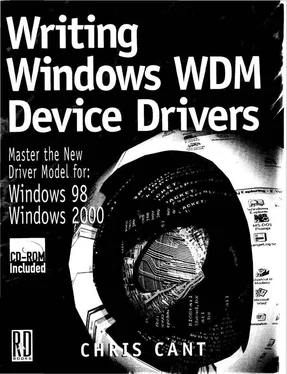Chris Cant - Writing Windows WDM Device Drivers
Здесь есть возможность читать онлайн «Chris Cant - Writing Windows WDM Device Drivers» весь текст электронной книги совершенно бесплатно (целиком полную версию без сокращений). В некоторых случаях можно слушать аудио, скачать через торрент в формате fb2 и присутствует краткое содержание. Город: Lawrence, Kansas 66046, ISBN: , Издательство: R & D Books, Жанр: Программирование, на английском языке. Описание произведения, (предисловие) а так же отзывы посетителей доступны на портале библиотеки ЛибКат.
- Название:Writing Windows WDM Device Drivers
- Автор:
- Издательство:R & D Books
- Жанр:
- Год:неизвестен
- Город:Lawrence, Kansas 66046
- ISBN:0-87930-565-7
- Рейтинг книги:5 / 5. Голосов: 1
-
Избранное:Добавить в избранное
- Отзывы:
-
Ваша оценка:
- 100
- 1
- 2
- 3
- 4
- 5
Writing Windows WDM Device Drivers: краткое содержание, описание и аннотация
Предлагаем к чтению аннотацию, описание, краткое содержание или предисловие (зависит от того, что написал сам автор книги «Writing Windows WDM Device Drivers»). Если вы не нашли необходимую информацию о книге — напишите в комментариях, мы постараемся отыскать её.
Writing Windows WDM Device Drivers — читать онлайн бесплатно полную книгу (весь текст) целиком
Ниже представлен текст книги, разбитый по страницам. Система сохранения места последней прочитанной страницы, позволяет с удобством читать онлайн бесплатно книгу «Writing Windows WDM Device Drivers», без необходимости каждый раз заново искать на чём Вы остановились. Поставьте закладку, и сможете в любой момент перейти на страницу, на которой закончили чтение.
Интервал:
Закладка:
The Interrupt Level should not be confused with the scheduling priority. All threads normally run at the lowest interrupt level, PASSIVE_LEVEL. The scheduler uses the priority values to determine which thread to run next. Any other interrupt takes priority over a thread.
Drivers need to be aware of scheduling priorities. When it completes an IRP, it can give the calling thread a temporary priority boost so that, for example, programs that interact with the mouse can continue their run more quickly. This technique generally improves the perceived responsiveness of the system.
Any routine servicing a hardware interrupt stops normal program execution. For this reason, it is best to make an interrupt service routine as quickly as possible.
Any nonessential interrupt processing should be deferred until later. Windows lets driver writers use Deferred Procedure Call (DPC) routines, which are called at DISPATCH_LEVEL. The interrupt routine requests that the driver's DPC post-interrupt routine (DpcForIsr) is called when things have calmed down. A typical job in this routine is to indicate that the current I/O request is complete; the relevant kernel call can only be carried out at DISPATCH_LEVEL
When writing your driver, be careful to comment the interrupt level at which each routine can be called. Similarly, make only kernel calls that are appropriate for the current interrupt level.
Using Memory
A device driver has to be very careful when allocating or accessing memory. However, it is not as gruesome to access memory as some other types of driver. For example, you do not need to worry about the murky x86 world of segments and selectors, as the kernel handles all this stuff.
Windows implements virtual memory, where the system pretends that it has more memory than it really has. This allows more applications (and the kernel) to keep running than would otherwise be the case.
Virtual memory is implemented by breaking each application's potential address space into fixed size chunks called pages. (x86 processors have a 4KB-page size, while Alpha processors use 8KB.) A page can either be resident in physical memory, or not present and so swapped to hard disk.
Drivers can allocate memory that can be paged out, called paged memory. Alternatively, it can allocate memory that is permanently resident, called nonpaged memory. If you try to access paged memory at DISPATCH_LEVEL or above, you will cause a page fault and the kernel will crash. If you access nonresident paged memory at PASSIVE_LEVEL, the kernel will block your thread until the memory manager loads the page back into memory.
Please do not make extravagant use of nonpaged memory. However, you will find that most of the memory your driver uses will be in nonpaged memory. You must use nonpaged memory if it is going to be accessed at DISPATCH_LEVEL or above. Your driver StartIo and ISRs, for example, can access only nonpaged memory.
Table 3.4 shows how to allocate both paged and nonpaged memory using the kernel ExAllocatePool function. The table uses the DDK convention of listing IN or OUT before each parameter. IN parameters contain information that is passed to the function, and vice versa. Instances of IN and OUT in DDK header files are removed using macros.
Specify the ExAllocatePool PoolType parameter as PagedPool if you want to allocate paged memory or NonPagedPool if you want to allocate nonpaged memory. The other PoolType values are rarely used. Do not forget to check whether a NULL error value was returned by ExAllocatePool. The ExAllocatePool return type is PVOID, so you will usually need to cast the return value to the correct type.
When you are finished using the memory, you must release it using ExFreePool, passing the pointer you obtained from ExAllocatePool. Use ExFreePool for all types of memory. If you forget to free memory, it will be lost forever, as the kernel does not pick up the pieces after your driver has unloaded.
The ExAllocatePoolWithTag function associates a four-letter tag with the allocated memory. This makes it easier to analyze memory allocation in a debugger or in a crash dump.
Table 3.4 ExAllocatePool function
PVOID ExAllocatePool |
(IRQL<=DISPATCH_LEVEL)If at DISPATCH_LEVEL, use one of the NonPagedXxx values |
|---|---|
| Parameter | Description |
IN POOL_TYPE PoolType |
PagedPool PagePoolCacheAligned NonPagedPool NonPagedPoolMustSucceed NonPagedPoolCacheAligned NonPagedPoolCacheAlignedMustS |
IN ULONG NumberOfBytes |
Number of bytes to allocate |
| Returns | Pointer to allocated memory or NULL |
If your driver keeps on allocating and deallocating small amounts of pool memory then it will be inefficient and the available heap will fragment. The kernel helps in this case by providing lookaside lists [6] NT 3.51 drivers should use zone buffers, which are now obsolete.
for fixed-size chunks of memory. A lookaside list still gets memory from the pool. However, when you free a chunk of memory, it is not necessarily returned to the pool. Instead, some chunks are kept in the lookaside list, ready to satisfy the next allocation request. The number of chunks kept is determined by the kernel memory manager.
Lookaside lists can contain either paged or nonpaged memory. Use ExInitializeNPagedLookasideList to initialize a lookaside list for nonpaged memory and ExDeleteNPaged-LookasideList to delete the lookaside list. When you want to allocate a chunk of memory, call ExAliocateFromNPagedLookasideList. To free a chunk, call ExFreeToNPaged-LookasideList. A similar set of functions is used for paged memory. Consult the DDK for full details of these functions.
The kernel stack is nonpaged memory for local variables [7] Actually, the kernel stack may be paged if a driver issues a user-mode wait (e.g. in KeWaitForSingleObject ).
. There is not room for huge data structures on the kernel stack because it is only 8KB-12KB long.
Drivers need to be reentrant, so they can be called simultaneously on different processors. The use of global variables is, therefore, strongly discouraged. However, you might read in some registry settings into globals, as they are effectively constant for all the code. Local static variables should also not normally be used for the same reason.
Finally, you can reduce your driver's memory usage in other ways. Once the driver initialization routines have completed, they will not be needed again, so they can be discarded. Similarly, some routines may be put into a pageable code segment. However, routines running at DISPATCH_LEVEL or above need to be in nonpageable nondiscardable memory.
There are two main techniques for accessing user data buffers. If you use Buffered I/O, the I/O Manager lets you use a nonpaged buffer visible in system memory for I/O operations. The I/O Manager copies write data into this buffer before your driver is run, and copies back read data into user space when the request has completed.
The alternative technique, Direct I/O, is preferable, as it involves less copying of data. However, it is slightly harder to use and is usually only used by DMA drivers that transfer large amounts of data. The I/O Manager passes a Memory Descriptor List (MDL) that describes the user space buffer. While a driver can make the user buffer visible in the system address space, the MDL is usually passed to the DMA handling kernel routines.
Читать дальшеИнтервал:
Закладка:
Похожие книги на «Writing Windows WDM Device Drivers»
Представляем Вашему вниманию похожие книги на «Writing Windows WDM Device Drivers» списком для выбора. Мы отобрали схожую по названию и смыслу литературу в надежде предоставить читателям больше вариантов отыскать новые, интересные, ещё непрочитанные произведения.
Обсуждение, отзывы о книге «Writing Windows WDM Device Drivers» и просто собственные мнения читателей. Оставьте ваши комментарии, напишите, что Вы думаете о произведении, его смысле или главных героях. Укажите что конкретно понравилось, а что нет, и почему Вы так считаете.






